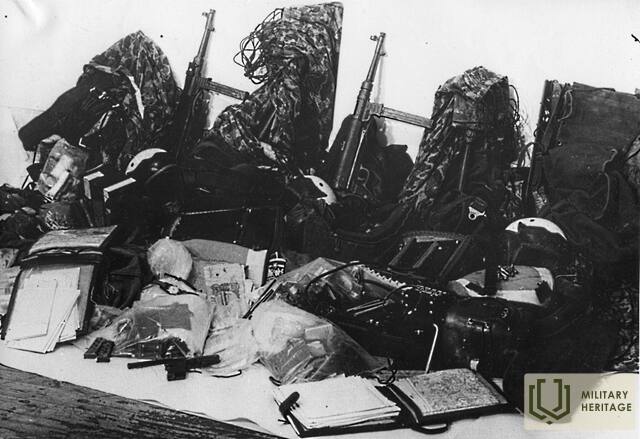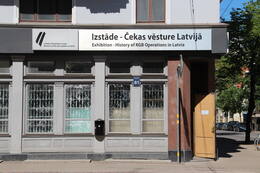Alfredas Riekstinas, pravarde „Imants“, žuvo dėl sovietų dvigubo agento išdavystės.

Latvijos legionierius Alfredas Riekstinas po Antrojo pasaulinio karo buvo užverbuotas dirbti JAV žvalgybos agentūroje CŽV.
Alfredas Riekstinas (slapyvardis „Imants“, bendravimui su JAV vyriausybinėmis institucijomis „Ogor A. Feldman“, kriptonas CAMUSO/1). Riekstinas gimė 1913 m. Sabilyje, baigęs Sabilės pradinę mokyklą, dirbo laukuose savo krikštatėvio Fričio Lagzdino ūkyje Dreimaniuose, Abavos valsčiuje.
Kovodamas Latvijos legione, jis pasiekė leitenanto laipsnį. Už didvyriškumą mūšyje jam buvo įteiktas Geležinio kryžiaus Riterio kryžius, II ir I klasių Geležiniai kryžiai, Pėstininkų puolimo medalis, Artimos kovos medalis ir Sužeidimų medalis. 1945 m. gegužę, Vokietijai kapituliuojant, jam pavyko paskutiniu laivu iš Kuršo pasiekti Švediją. Švedijoje apsimetęs civiliu, jis išvengė internavimo karo belaisvių stovykloje ir vėlesnės ekstradicijos atgal į SSRS.
Sutarė bendradarbiauti 1951 m.
su britų ir amerikiečių slaptosiomis tarnybomis, siekdamas, veikdamas SSRS okupuotose teritorijose, gauti sąjungininkams reikalingą informaciją ir netiesiogiai prisidėti prie Latvijos nepriklausomybės atkūrimo. Riekstiņš buvo padalintas į penkių vyrų grupę, kuriuos planuota slapta išgabenti į Latviją. Kartu su keliais kitais latviais jis buvo apmokytas JAV žvalgybos mokyklose Bavarijoje, Vakarų Vokietijoje.
1952 m. rugpjūčio 30 d. Riekstinas, pravarde „Imants“, atvyko į Kuršą. Kartu su dar dviem latviais – Edvīnu Ozoliņu („Herbert“) ir Nikolajumi Balodžiu („Boris“) – jį Priekulės apylinkėse nuskraidino JAV žvalgybos tarnybos atsiųstas dvimotoris lėktuvas.
„Imants“ ir „Herberts“ naktį slapta nuvyko į netoli Sabilės esančius „Dreimanių“ namus, kurie Riekstinai jau buvo gerai žinomi. Tačiau po vos keturių dienų namus apsupo Čekos kariuomenė. 1952 m. rugsėjo 11 d., po trumpo susišaudymo, supratęs pasipriešinimo beprasmybę, Riekstinas panaudojo gautą kalio cianido ampulę ir nusižudė. Edvīns Ozolinis išėjo ir pasiskelbė esąs SSRS agentas, pravarde „Pilotas“.
https://www.lsm.lv/raksts/dzive--stils/vesture/kgb-slepenie-arhivi.-spiegu-speles-latvija-cia-agenti-psrs-dienesta.a261845/
Uldis Neiburgsas. Apie Latviją iki paskutinio // Namų svečias, Nr. 17 (2009 m. spalio 23 d.)
Susijusi laiko juosta
Susijusios vietos
Paroda KGB pastate „KGB operacijų Latvijoje istorija“
Buvęs SSRS Valstybės saugumo komiteto (paprastai vadinamas Čeka) pastatas atviras lankytojams. Čia čekistai kalindavo, tardydavo ir žudydavo Latvijos piliečius, kuriuos okupacinis režimas laikė priešininkais. Taip pat eksponuojama Latvijos okupacijos muziejaus ekspozicija apie Čekos veiklą Latvijoje. Siūlomos ekskursijos po kalėjimo kameras, koridorius, rūsį ir kiemą. Namas pastatytas 1911 m. ir yra vienas gražiausių pastatų Rygoje. Liaudyje vadinamas „Kampiniu namu“, jis buvo baisiausias sovietinio okupacinio režimo simbolis Latvijoje ir vienas iš SSRS valdžios ramsčių. Čeka iš Kampinio namo veikė okupacijos metu nuo 1940 iki 1941 m., o vėliau nuo 1945 iki 1991 m. Dešimtys tūkstančių latvių nukentėjo nuo tiesioginio politinio persekiojimo. Kova su sovietų valdžios priešais tęsėsi ir po Antrojo pasaulinio karo. Čekos požiūris į savo veiklą šiek tiek pasikeitė po Stalino mirties. Fizinį kankinimą pakeitė psichologinis teroras. Dauguma Čekos agentų buvo latviai (52 %). Antra pagal dydį grupė buvo rusai – 23,7 %. 60,3 % agentų nebuvo Komunistų partijos nariai. 26,9 % agentų turėjo aukštąjį išsilavinimą. Sistema buvo sukurta taip, kad įtrauktų vietos gyventojus ir taip turėtų didesnę kontrolę visuomenėje. Personalo dokumentai ir tarnybos įrašai yra Rusijoje. Ši medžiaga nebuvo prieinama Latvijos valdžios institucijoms ir tyrėjams.







